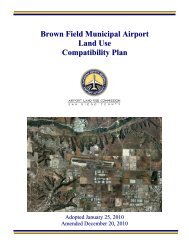Draft EA - San Diego International Airport
Draft EA - San Diego International Airport
Draft EA - San Diego International Airport
You also want an ePaper? Increase the reach of your titles
YUMPU automatically turns print PDFs into web optimized ePapers that Google loves.
SAN DIEGO INTERNATIONAL AIRPORT – PROPOSED RUNWAY 9 DISPLACED THRESHOLD<br />
Proposed Action also includes relocation of some of the existing MALSR lights that extend into the Navy Boat<br />
Channel. However, relocation of these lights would occur onto existing light stations – no fill or construction<br />
would occur in the Navy Boat Channel. Thus, no impact to fish, wildlife, and plants would occur as a result of<br />
the Proposed Action.<br />
4.11 Department of Transportation Act, Section 4(f)/303(c)<br />
Properties<br />
49 U.S.C. Section 303(c), commonly referred to as Section 4(f) of the DOT Act, states that it is federal policy<br />
that special effort should be made to preserve the natural beauty of the countryside and public park and<br />
recreation lands, wildlife and waterfowl refuges, and historic sites. Under Section 4(f), FAA may approve a<br />
program or project requiring the use of publicly owned land of a public park, recreation area, or wildlife and<br />
waterfowl refuge of national, State, or local significance, or land of a historic site of national, State, or local<br />
significance only if: (1) there is no prudent and feasible alternative to using that land; and (2) the program or<br />
project includes all possible planning to minimize harm to the park, recreation area, wildlife and waterfowl<br />
refuge, or historic site resulting from the use.<br />
This analysis also examines whether there would be a change in the use of a recreational park or facility<br />
funded through the Department of the Interior Land and Water Conservation Fund Act of 1965 (L&WCF Act).<br />
If a change from a recreational to a non-recreational use were to occur, it would be considered a "conversion"<br />
under the L&WCF Act. Conversion of parks funded through L&WCF grants is defined by regulations and<br />
guidelines issued by the National Park Service to implement Section 6(f) of the L&WCF Act. Section 6(f)<br />
properties are considered in the same manner as Section 4(f) properties. There are no Section 6(f) properties<br />
on or adjacent to SDIA.<br />
Both direct and indirect adverse impacts to Section 4(f) properties are considered. Direct impacts include any<br />
physical taking of the property. Indirect adverse impacts, such as noise, which conflict with the public use of<br />
Section 4(f) properties or adversely affect the context of historic sites, are considered a constructive use, or<br />
taking of the property, if normal activities of the property are incompatible with FAA guidelines on noise and<br />
land use.<br />
Parks, recreational areas, wildlife refuges, and historic sites are classes of land use which may be noisesensitive<br />
depending upon the specific use of the site. Sites that might be substantially impaired by excessive<br />
noise are amphitheaters, campgrounds, or other areas where a quiet setting is a significant attribute of the<br />
resource.<br />
4.11.1 METHODOLOGY<br />
Existing recreation resources near SDIA were documented through review of applicable plans (e.g., Port of <strong>San</strong><br />
<strong>Diego</strong> PMP) and maps, and through field reconnaissance. According to FAA Order 1050.1E, a significant<br />
impact would occur to Section 4(f) or 6(f) areas “when a proposed action involves more than a minimal<br />
physical use of a section 4(f) property or is deemed a “constructive use” substantially impairing the Section<br />
Environmental Consequences<br />
[4-26]<br />
<strong>Draft</strong> <strong>EA</strong>
















